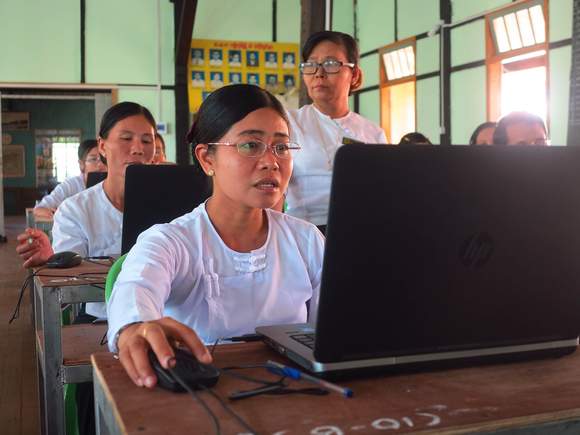Via UNESCO
As the ‘ICT for Education: Mobile Broadband in Myanmar’ conference is set to get underway in Yangon, a look back at 18 months of UNESCO and partners’ groundbreaking initiative
Eighteen months ago, UNESCO set out to introduce ICT-pedagogy integration in Myanmar classrooms. While the rest of Asia-Pacific is tweeting and chatting on its tablets and smartphones, rural schools in Myanmar are just now discovering ICT. “When I teach the chapter about earthquakes, I can show videos to the students rather than merely newspaper clippings,” says Daw Ei Mon Aung, who teaches English in the Bago region of central Myanmar.
Daw Ei Mon Aung is among 155 teachers across 31 rural schools in Myanmar who was trained by UNESCO and the Myanmar Department of Basic Education to use ICT in her work. Whether to enrich classroom lessons with sounds and images, to be connected to a network of teachers sharing good practice, or to foster digital citizenship in Myanmar, ICT has tremendous potential to improve the quality of education at a time when its use is booming in the country.
In 2014, reforms in Myanmar’s mobile communications services significantly lowered the cost of SIM cards, and led to a three-fold increase in the number of mobile phone subscribers in only one year. Some 84% of these subscribers are using smartphones, giving UNESCO and partners the impetus needed to launch the ICT for Education in Myanmar project in 2014/15. Since then, steps have been taken, for the first time in Myanmar, to promote the use of mobile broadband and ICT in teaching in rural schools.
Across the regions of Mandalay, Bago, and the Mon state, UNESCO programme staff and experts tirelessly trained 22 government officials, 155 teachers, 17 township education officers and 31 school leaders not only to use ICT for innovative teaching approaches, but also to spread their knowledge among peers and pupils, organically growing Myanmar’s ICT skills.
Mandalay, Bago and the Mon state are home to many rural and semi-urban schools teaching marginalized children, thus the use of ICT in classrooms can be critical in shifting from a top-down, teacher-oriented class, to a student-centered approach to learning.
With the help of Ericsson, UK Department for International Development (DFID) and Qualcomm, the project distributed 3,100 tablets and 186 laptops for teachers to use at the 31 target schools. The tailor-made LoudClass app provided by UNESCO was a particular favorite among Myanmar teachers in making their classrooms more interactive, with real-time assessment of student learning.
In just 18 months, teachers involved in UNESCO’s project have gone from having little to no ICT knowledge, to harnessing ICT to create engaging, child-centered lessons. From March 28th to 30th, UNESCO and all stakeholders in the project will be gathering in Yangon to celebrate and reflect on the progress made so far in promoting ICT for education in Myanmar.
By fostering exchanges on good practice and harnessing involvement from donors and partners, UNESCO aims to contribute to improving the quality of education in Myanmar, equipping future generations with the skills they need to face the challenges and opportunities of the 21st century world.
Follow and join the discussion on the ‘ICT for Education: Mobile Broadband in Myanmar’ project on social media using the hashtag #ICT4EMyanmar.
For more: Rural Myanmar teachers turn on ICT, transform classrooms (project overview)
By Alexandra Stenbock-Fermor



